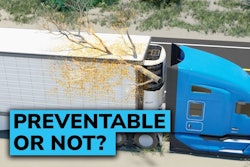Trucking news and briefs for Monday, Oct. 2, 2023:
NHTSA: Traffic fatalities trending down
The National Highway Traffic Safety Administration last week released its early estimates of traffic fatalities for the first half of 2023, noting a decline for the fifth straight quarter.
An estimated 19,515 people died in motor vehicle traffic crashes in the first half of the year, down about 3.3% from the 20,190 fatalities in the first half of 2022. The preliminary report did not include vehicle-specific data, so it’s unclear how truck-involved crashes are trending so far this year.
 NHTSA estimated a decrease in traffic fatalities in the first half of 2023 compared to the first half of 2022, despite an increase in overall vehicle miles traveled.NHTSA
NHTSA estimated a decrease in traffic fatalities in the first half of 2023 compared to the first half of 2022, despite an increase in overall vehicle miles traveled.NHTSA
“While we are encouraged to see traffic fatalities continue to decline from the height of the pandemic, there’s still significantly more work to be done,” NHTSA Acting Administrator Ann Carlson said. “NHTSA is addressing traffic safety in many ways, including new rulemakings for lifesaving vehicle technologies and increased Bipartisan Infrastructure Law funding for state highway safety offices. We will continue to work with our safety partners to meet the collective goal of zero fatalities.”

[Related: 'False-positive' reports suggest AEBs not ready for prime time]
NHTSA estimated a decrease in fatalities in 29 states, while 21 states, Puerto Rico, and the District of Columbia, are projected to have experienced increases.
NHTSA has announced several initiatives aimed at reducing traffic deaths, including proposed rulemakings to require automatic emergency braking systems in passenger cars, light trucks and heavy vehicles.
The agency has also published a proposed rule for seat belt warning systems and issued a Standing General Order to collect more data about crashes that occur when automated driving systems and advanced driver assistance systems are engaged.
[Related: NHTSA estimates traffic fatalities down for fourth straight quarter]
Court rules broker not liable after post-crash suit
An Illinois appellate court has ruled that a broker was not liable in a case involving the family of a man who was struck by the truck driver of a motor carrier contracted to haul a load for the broker.
The case -- Francine Cornejo v. Dakota Lines, Gordon Lewis (the driver) and Alliance Shippers (the broker) -- was brought by Cornejo, the mother of Gustavo Cornejo Jr., who was severely injured when he was standing near his family’s vehicle on the shoulder of a highway and was struck by an 18-wheel tractor-trailer. Cornejo alleged negligence from the trucking company, Dakota Lines; its driver, Gordon Lewis; and Alliance Shippers, the broker that contracted Dakota to transport automotive parts on behalf of its client.
A jury initially found all three defendants were liable in the crash and awarded Cornejo $18,150,750.
Alliance Shippers appealed the ruling, arguing that Dakota Lines was an independent contractor and neither Lewis nor Dakota were agents of Alliance.
According to court documents, Lewis was an employee of Dakota and never had any communication with the broker. “Alliance did not provide Lewis with any tools, equipment, or materials. Alliance did not own the tractor or trailer. Alliance did not have the power to hire or fire Dakota drivers but could request that a driver be removed from a route. Alliance was Dakota’s second or third largest customer but Dakota was not Alliance’s primary carrier,” the opinion reads.
Additionally, the contract between Dakota and Alliance specified that Dakota was an independent contractor, Dakota and Alliance would not be considered the agent of the other, and Dakota was solely responsible for its employees and agents.
The original jury in the case referred to evidence of Alliance’s marketing material mentioning timely deliveries and the ability to request another Dakota driver, even though Alliance could not fire any Dakota driver, as examples of Alliance’s control over Lewis.
In reversing the trial court’s decision, the appellate court said it was “undisputed that Dakota and Alliance adhered to the terms of their agreement, which provided that Dakota had full control over its personnel and would perform services as an independent contractor,” adding that the two companies did not have an exclusive relationship, meaning Dakota was free to haul for other brokers.
This isn’t the first case involving whether brokers should be held liable for the safety outcomes of carriers they contract with. A case involving broker C.H. Robinson resulted in the broker being found liable, though in that case, the carrier showed out-of-service rates above the national average in the FMCSA's CSA Safety Measurement System, as well as adverse inspections/violations in the various measurement categories there.
[Related: Will broker negligence suits ripple out to limit owner-operator opportunity?]
Wabash recalling lift-gate-equipped dry vans
Wabash National Corporation is recalling approximately 3,448 model year 2009-‘24 dry van trailers equipped with a rail-style lift gate, according to National Highway Traffic Safety Administration documents.
In the affected units, the location of the rear impact guard is too far forward from the rear of the trailer, reducing impact protection. As such, the trailers don’t meet the requirements of Federal Motor Vehicle Safety Standard number 224, "Rear Impact Protection."
In the event of a rear impact crash, the rear impact guard may not sufficiently protect light duty vehicles, increasing the risk of injury, the recall states.
Wabash said the “addition of a rail style lift gate was not taken into account when calculating the rear-most extremity of the vehicle,” leading to the misplaced rear impact guards.
Dealers will add an extension to the rear impact guard, free of charge. Owner notification letters are expected to be mailed Nov. 17. Owners can contact Wabash customer service at 765-771-5404. NHTSA’s recall number is 23V-646.
[Related: It's official: Nikola truck fires prompt battery-electric recalls]
Hendrickson acquiring Brunner International
Hendrickson on Monday announced it has acquired Brunner International, a New York-based manufacturer of commercial vehicle axle shafts, brake shoes and s-cams. Brunner Manufacturing and Sales LTD, based in Niagara Falls, Ontario, Canada, is also part of the deal.
Brunner’s brake shoes and s-cams complement Hendrickson’s primary business of designing and manufacturing suspension systems for the medium- and heavy-duty truck and trailer markets.
The Brunner product brand will be kept and used going forward, and Brunner will operate as a division of Hendrickson Brake and Wheel End. Its approximately 325 employees will become employees of Hendrickson.
“We are excited about this acquisition, as it will provide a platform for Hendrickson to expand our core competency in braking and provide additional components that will enhance our existing product portfolio,” said Matt Joy, president and chief executive officer of Hendrickson. “We look forward to working with our new associates and strengthening our business.”










